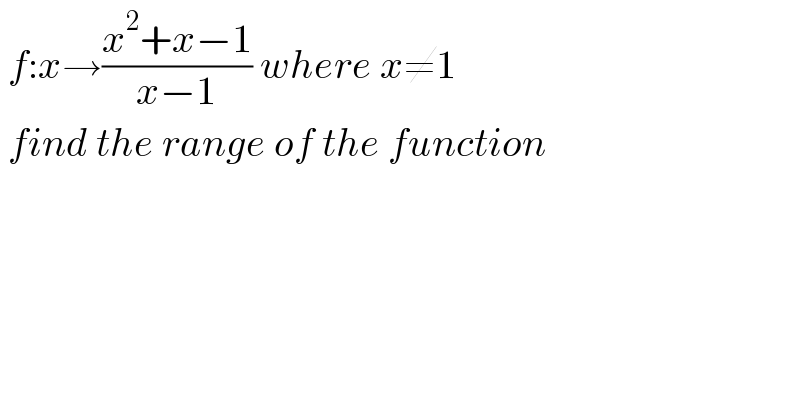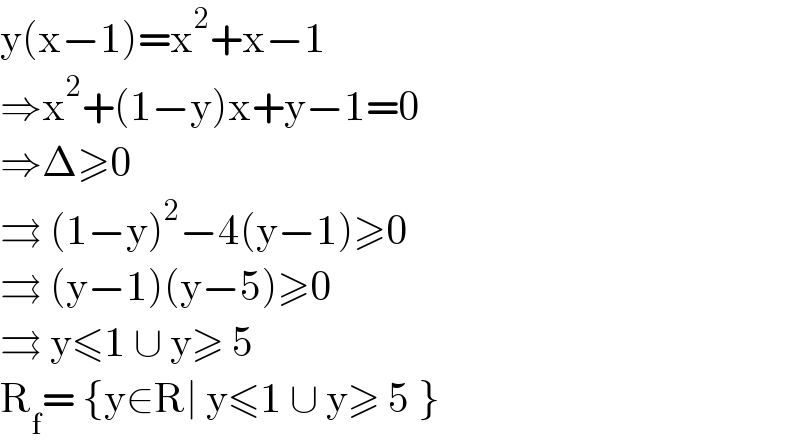
Question Number 148241 by 7770 last updated on 26/Jul/21

$$\:{f}:{x}\rightarrow\frac{{x}^{\mathrm{2}} +{x}−\mathrm{1}}{{x}−\mathrm{1}}\:{where}\:{x}\neq\mathrm{1} \\ $$$$\:{find}\:{the}\:{range}\:{of}\:{the}\:{function} \\ $$
Answered by Olaf_Thorendsen last updated on 26/Jul/21
![f(x) = ((x^2 +x−1)/(x−1)) = x+2+(1/(x−1)) lim_(x→±∞) f(x) = ±∞, limf(x) = ±∞_(x→1^± ) f′(x) = 1−(1/((x−1)^2 )) f′(x) = 0 ⇔ x = 2 f(0) = 1 and f(2) = 5 ∀x∈]0,1[∪]1,2[, f′(x) < 0 ∀x∈]−∞,0[∪]2,+∞[, f′(x) > 0 f(]−∞,0]) = ]−∞,1] f([0,1[) = [−∞,1] f(]1,2]) = [5,+∞] f([2,+∞[) = [5,+∞] • f(R\{1}) = R\]1,5[](Q148245.png)
$${f}\left({x}\right)\:=\:\frac{{x}^{\mathrm{2}} +{x}−\mathrm{1}}{{x}−\mathrm{1}}\:=\:{x}+\mathrm{2}+\frac{\mathrm{1}}{{x}−\mathrm{1}} \\ $$$$\underset{{x}\rightarrow\pm\infty} {\mathrm{lim}}{f}\left({x}\right)\:=\:\pm\infty,\:\underset{{x}\rightarrow\mathrm{1}^{\pm} } {\mathrm{lim}{f}\left({x}\right)\:=\:\pm\infty} \\ $$$$ \\ $$$${f}'\left({x}\right)\:=\:\mathrm{1}−\frac{\mathrm{1}}{\left({x}−\mathrm{1}\right)^{\mathrm{2}} } \\ $$$${f}'\left({x}\right)\:=\:\mathrm{0}\:\Leftrightarrow\:{x}\:=\:\mathrm{2} \\ $$$${f}\left(\mathrm{0}\right)\:=\:\mathrm{1}\:\mathrm{and}\:{f}\left(\mathrm{2}\right)\:=\:\mathrm{5} \\ $$$$\left.\forall{x}\in\right]\mathrm{0},\mathrm{1}\left[\cup\right]\mathrm{1},\mathrm{2}\left[,\:{f}'\left({x}\right)\:<\:\mathrm{0}\:\right. \\ $$$$\left.\forall{x}\in\right]−\infty,\mathrm{0}\left[\cup\right]\mathrm{2},+\infty\left[,\:{f}'\left({x}\right)\:>\:\mathrm{0}\right. \\ $$$$ \\ $$$$\left.{f}\left.\left(\left.\right]\left.−\infty,\mathrm{0}\right]\right)\:=\:\right]−\infty,\mathrm{1}\right] \\ $$$${f}\left(\left[\mathrm{0},\mathrm{1}\left[\right)\:=\:\left[−\infty,\mathrm{1}\right]\right.\right. \\ $$$$\left.{f}\left.\left(\right]\mathrm{1},\mathrm{2}\right]\right)\:=\:\left[\mathrm{5},+\infty\right] \\ $$$${f}\left(\left[\mathrm{2},+\infty\left[\right)\:=\:\left[\mathrm{5},+\infty\right]\right.\right. \\ $$$$ \\ $$$$\left.\bullet\:{f}\left(\mathbb{R}\backslash\left\{\mathrm{1}\right\}\right)\:=\:\mathbb{R}\backslash\right]\mathrm{1},\mathrm{5}\left[\right. \\ $$$$ \\ $$
Answered by liberty last updated on 26/Jul/21

$$\mathrm{y}\left(\mathrm{x}−\mathrm{1}\right)=\mathrm{x}^{\mathrm{2}} +\mathrm{x}−\mathrm{1} \\ $$$$\Rightarrow\mathrm{x}^{\mathrm{2}} +\left(\mathrm{1}−\mathrm{y}\right)\mathrm{x}+\mathrm{y}−\mathrm{1}=\mathrm{0} \\ $$$$\Rightarrow\Delta\geqslant\mathrm{0}\: \\ $$$$\rightrightarrows\:\left(\mathrm{1}−\mathrm{y}\right)^{\mathrm{2}} −\mathrm{4}\left(\mathrm{y}−\mathrm{1}\right)\geqslant\mathrm{0} \\ $$$$\rightrightarrows\:\left(\mathrm{y}−\mathrm{1}\right)\left(\mathrm{y}−\mathrm{5}\right)\geqslant\mathrm{0} \\ $$$$\rightrightarrows\:\mathrm{y}\leqslant\mathrm{1}\:\cup\:\mathrm{y}\geqslant\:\mathrm{5} \\ $$$$\mathrm{R}_{\mathrm{f}} =\:\left\{\mathrm{y}\in\mathrm{R}\mid\:\mathrm{y}\leqslant\mathrm{1}\:\cup\:\mathrm{y}\geqslant\:\mathrm{5}\:\right\} \\ $$
